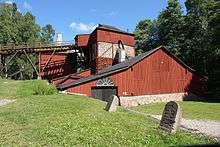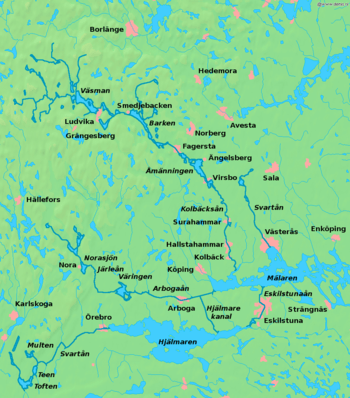Bergslagen
Bergslagen is a vaguely defined area in Svealand in central Sweden. It is known as the historical heartland of Swedish mining, metallurgy and industry. During the 20th century most mines closed down making Malmfälten in Kiruna Municipality the de facto centre of Swedish mining. However, several industrial and mining heritages remains including the two ![]()


The area contains large parts of Västmanland, Dalarna (called Dalabergslagen) and Värmland (called Värmlands bergslag). More inclusive definitions also tend to include adjoined parts of Närke, Södermanland County, Östergötland, Uppsala County and Gävleborg county.
Traditional mining and industrial sites
- 🌍
Fagersta — An iron works in Västmanland. Its mine is a

- 🌍
Falun — A copper mine in Dalarna. One of the largest mines in Bergslagen. Its mine is a

- 🌍 Filipstad — An iron mine in Värmland.
- 🌍 Hofors — An iron works and steel industry in Gävleborg county.
- 🌍 Kristinehamn — An iron works and steel industry in Värmland.
- 🌍 Ludvika — An iron works and sawmill in Dalarna.
- 🌍 Nora — An iron works in Västmanland.
- 🌍 Sala — A silver mine in Västmanland.
Understand
The oldest traces of mining in Bergslagen have been found in Röda jorden (the Red Earth) in Skinnskatteberg, Västmanland, and dates to the bronze age around the 8th century B.C. During the middle ages the are was increasingly populated in order to utilize the easily available ore. Bergslagen is first mentioned in written sources in the 14th century as royal mining charter's. Every charter was designated to a collective with their own jurisdiction called "Bergslag", hence the name for the area. During the 16th, 17th and 18th centuries the mining expanded and Bergslagen became the "iron basket" of Europe, supplying most of the ore for guns and cannons used in European warfare. During this era many skilled laborers from Europe, most notably from Wallonia, migrated to work in Bergslagen.
During the 19th century industry was concentrated to the largest industries, leading to "Bruksdöden", the death of several smaller works. During the 20th century Bergslagen lost many of its competitive advantages. For example, Bergslagen's water power became less relevant as alternative sources of energy where adopted, and with reduced transportation costs Bergslagen's location in central Sweden became less of an advantage. With the international steel crisis in the 1970s most of the remaining mines where closed down, making Malmfälten in Kiruna Municipality the largest mining area in Sweden. Today Garpenberg mine, dating to the 14th century, is the only remaining mine operating in Bergslagen.
Get in
By plane
Stockholm Arlanda Airport ARN IATA, while located outside of Bergslagen, is by far the largest airport in Svealand. 🌍 Dala Airport (BLE IATA) (outside of Borlänge). and 🌍 Stockholm Västerås Airport (VST IATA) (just 4 miles/6km from the centre of Västerås). are smaller but closer to the heartland of Bergslagen.
Get around
See
- Ekomuseum Bergslagen, Nils Nils gata 7 Ludvika, ☎ +46 240 66 30 82, fax: +46 240 748 60, e-mail: info@ekomuseum.se. A decentralized open-air museum about the history of iron industry in western Berslagen. Started in 1986, today it has some 60 sites, making it the largest ecomuseum in the world. Notable sites include:
- 🌍
Engelsbergs bruk, Ängelsbergsvägen 4 (Fagersta), ☎ +46 223-300 62. A traditional ironworks and

- 🌍 Nya Lapphyttan & Karlbergs hembygdsmuseum (Lapphyttan & Karlberg Homestead Museum) (Norberg), ☎ +46 223 283 30. A reconstructed medieval village. Lapphyttan, dating to somewhere between 1150 and 1350, is considered the type site for the Medieval Blast Furnace.
- 🌍 Röda Jorden (The Red Earth) (Skinnskatteberg Municipality, Västmanland). The oldest known traces from metal working in Bergslagen comes from this site, dating to the 8th century BC.
- 🌍
Engelsbergs bruk, Ängelsbergsvägen 4 (Fagersta), ☎ +46 223-300 62. A traditional ironworks and
- 🌍
Falun Copper Mountain, Gruvplatsen 1, ☎ +46 23-78 20 30. A copper mine and

- 🌍 Garpenbergs gruva (Garpenbergs mine). Dating to the 14th century, this is the only remaining mine still operating in Bergslagen.
- 🌍 Sala Silvergruva, Drottning Christinas väg, ☎ +46 224-67 72 60. A silver mine closed in 1962. Today open for visitors during guided tours.
Do
Eat
The food most commonly associated with Bergslagen is "Falu sausage" (Swedish:Falukorv), traditionally made from draft oxen operating the Falu mine. The land is also great for foraging (which can be done freely, due to the right to roam), fishing (which usually requires a license) and hunting (which is very restricted).
Drink
Go next
- Siljansbygden in the non-Bergslagen part of Dalarna is often considered an epitome of Swedishness.